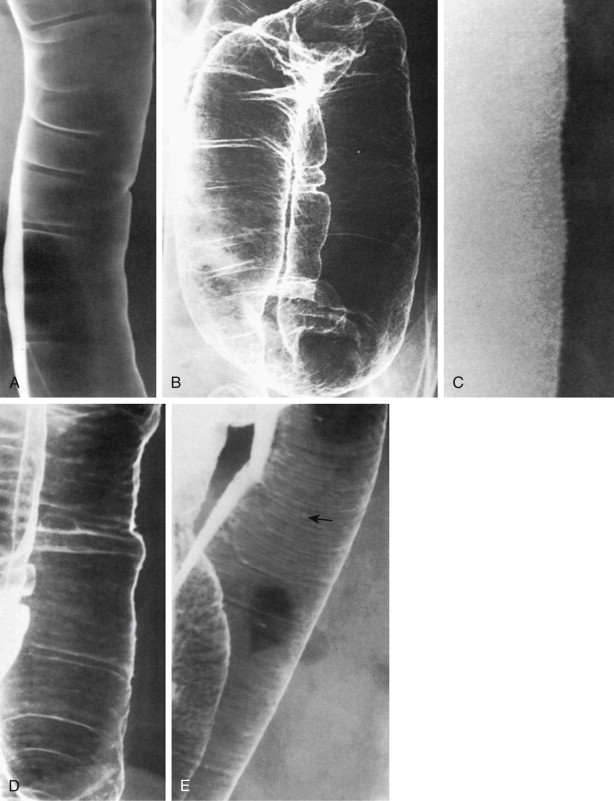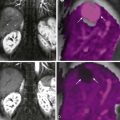Chapter Outline
Single- Versus Double-Contrast Technique
The overall volume of barium enemas has decreased considerably in modern medical practice because of greater use of other diagnostic tests such as colonoscopy, computed tomography (CT) and, most recently, CT colonography. Nevertheless, the barium enema remains a valuable technique for evaluating patients with a variety of colorectal diseases. The double-contrast barium enema, in particular, has been shown to be a viable alternative to colonoscopy for colorectal cancer screening and for detecting polyps and cancers in the proximal colon in patients with incomplete colonoscopy. Both single- and double-contrast barium enemas also have the ability to demonstrate a variety of intramural and extrinsic abnormalities involving the colon that are more difficult to recognize at colonoscopy. In such cases, the full extent of disease may then be assessed by cross-sectional imaging studies such as CT.
Depending on the clinical indications for the barium enema and the patient’s overall condition, single- or double-contrast techniques may be used to evaluate the colon. We believe that a double-contrast barium enema is generally the preferred examination because of its greater diagnostic capabilities, so it has received more emphasis in this chapter.
Single- Versus Double-Contrast Technique
Double-contrast technique is generally thought to be superior to single-contrast technique for detecting small polypoid lesions or flat carpet lesions (villous tumors) in the colon and for visualizing the early inflammatory changes of inflammatory bowel disease (Crohn’s disease and ulcerative colitis). This advantage of double-contrast technique is related to its ability to visualize the mucosal surface en face on double-contrast images. There are also specific signs such as the mucosal spiculation of endometriosis or metastatic disease that are better demonstrated on double-contrast studies (see Chapter 3 ). Finally, double-contrast technique enables evaluation of the rectum, which is not accessible to manual palpation on single-contrast studies.
In contrast, single-contrast technique entails filling of each colonic loop with a continuous column of barium, enabling visualization of contour abnormalities such as polyps or ulcers in profile and circumferential areas of narrowing such as annular carcinomas. Polyps and polypoid masses can also be visualized en face by thinning the barium column with graded compression to delineate these lesions as filling defects within the barium pool. Despite the limitations of single-contrast technique in detecting polyps, it is the preferred examination for patients with suspected fistulas, obstruction, or intussusception, in whom careful control of the barium column is required. Single-contrast technique is also useful for showing ischemic colitis associated with thumbprinting that can be effaced by gaseous distention of the colon on double-contrast studies. Finally, single-contrast technique is used for patients who are too old or too debilitated to perform the various maneuvers required for a double-contrast study or in patients with poor sphincter tone who may be unable to retain rectally administered air, even with inflation of a rectal balloon.
Double-Contrast Barium Enema
Preparation of the Patient
A variety of regimens may be used for cleansing the colon, but most include the following basic components :
- •
A clear liquid diet for 24 hours
- •
One or preferably two sets of laxatives on the afternoon and evening before the examination (e.g., one 16-ounce bottle of magnesium sulfate at 4 pm and four Dulcolax [bisacodyl] tablets at 10 pm )
- •
A suppository (e.g., a Dulcolax suppository) on the morning of the examination
- •
If followed properly, this basic preparation is usually effective in cleansing the colon, but noncompliance can be a problem. When patients arrive in the department, they should be asked whether they have taken the preparation and whether it has been effective in producing clear, watery bowel movements. If there is any doubt about the adequacy of the preparation, a preliminary abdominal radiograph should be obtained. If this radiograph shows definite fecal residue in the colon, the examination should be postponed for 24 hours while the patient repeats the preparation.
Cleansing enemas may improve the cleanliness of the colon but are not generally recommended because residual fluid in the colon may dilute administered barium and limit mucosal coating, compromising the examination. For similar reasons, oral lavage regimens with solutions used to prepare patients for colonoscopy, such as GoLYTELY (polyethylene glycol electrolyte solution), should be avoided.
Materials and Equipment
The choice of barium suspension is critical. A medium barium suspension of approximately 100% w/v is generally preferred for double-contrast barium enemas. Barium of this viscosity optimally coats the mucosa for a relatively prolonged period without precipitating or causing other artifacts. A Miller air enema tip is ideal for instilling barium and air into the colon. The retention balloon attached to the enema tip is inflated only if the patient is unable to retain the barium or air because of inadequate anal sphincter tone (see later, “ Insertion of Enema Tip ”).
In modern radiology departments, barium enema examinations are almost always performed on digital fluoroscopic equipment. For double-contrast studies, the radiologist relies on fluoroscopy to position the patient for a series of digital spot images, followed by a routine sequence of overhead radiographs (see next section, “ Routine Examination ”). Careful evaluation of the frozen image on the fluoroscopic monitor after each digital exposure enables the radiologist to better delineate subtle colonic abnormalities and differentiate spurious findings from true lesions at the time of fluoroscopy. The study is later reviewed at a computer workstation that allows routine postprocessing of the images for optimal interpretation. Subtle mucosal abnormalities and differences in density (e.g., as in patients with pneumatosis coli) may be apparent only after adjustment of the images.
Administration of Glucagon
A standard dose of 1 mg of glucagon should be administered intravenously to improve the quality of the examination and decrease patient discomfort by producing a relaxant effect on the colon and eliminating or minimizing colonic spasm. The glucagon should be injected slowly to avoid nausea and vomiting, a frequent but transient side effect. Glucagon can be given to almost all patients, but this agent is contraindicated in patients with pheochromocytomas or poorly controlled, insulin-dependent diabetes.
Insertion of Enema Tip
Before inserting the lubricated enema tip, a brief digital rectal examination should be performed to assess anal sphincter tone and recognize anatomic variations that could interfere with insertion of the tip. In patients with an enlarged prostate, for example, the enema tip should be directed more posteriorly than usual to facilitate passage into the rectum. In patients with large external hemorrhoids or anal fissures, a topical anesthetic may be applied to the anus and enema tip to minimize discomfort during insertion. Patients who experience unusual discomfort when the tip is inserted should be reassured that the rectum quickly accommodates to the tip, so any discomfort they experience will be transient.
Routine Examination
A routine series of fluoroscopic spot images for double-contrast barium enemas is presented in Table 51-1 , and selected views are illustrated in Figure 51-1 . When the fluoroscopic portion of the study has been completed, a standard sequence of overhead radiographs is also obtained (see Fig. 51-1 and Table 51-1 ). The overhead radiographs include horizontal beam views—left and right lateral decubitus radiographs and a prone cross-table lateral radiograph—that are especially useful for differentiating retained stool from true polypoid lesions in the colon ( Fig. 51-2 ).
| Position | Views |
|---|---|
| SPOT RADIOGRAPHS | |
| Prone | Rectum |
| Left posterior oblique | Sigmoid colon |
| Left lateral | Rectum |
| Supine | Rectum and cecum |
| Upright | Hepatic and splenic flexures |
| Supine, supine obliques | All remaining colonic segments |
| OVERHEAD RADIOGRAPHS | |
| Vertical beam | Posteroanterior |
| Angled (prone) | Rectosigmoid |
| Horizontal beam | Left and right lateral decubitus views |
| Prone cross-table lateral view |
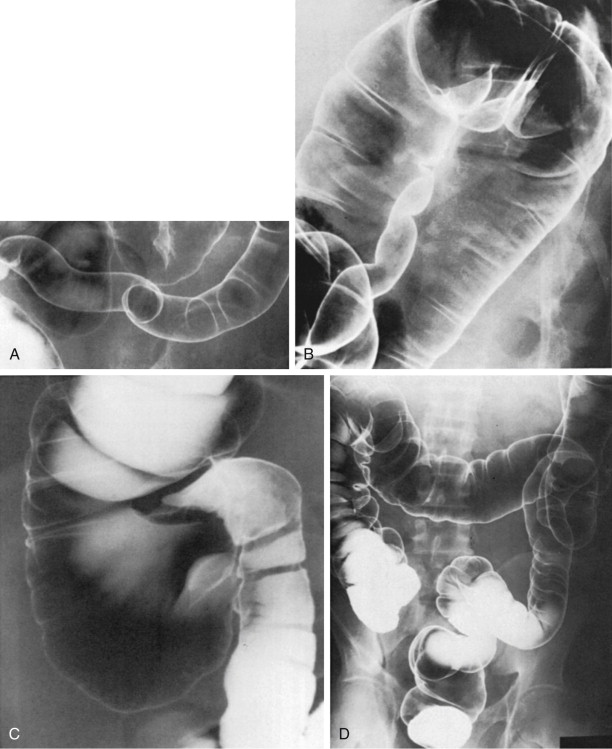
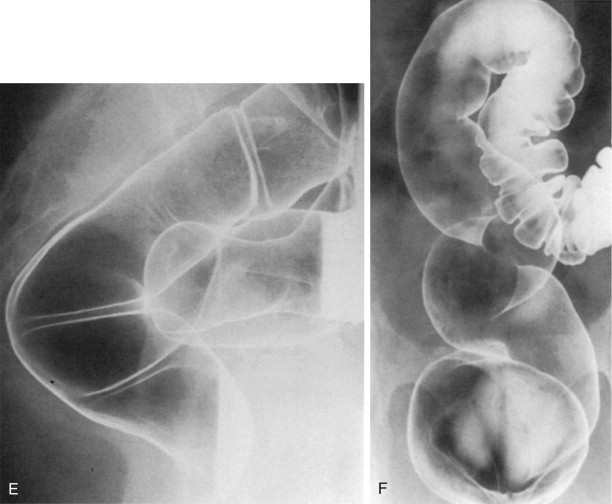
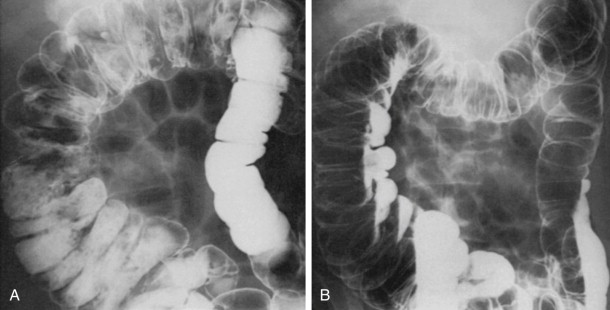
Barium is usually administered into the colon under fluoroscopic guidance with the patient in a prone or left lateral position to facilitate passage of barium into the dependent sigmoid and descending colon. It is important to be certain that barium has passed around the splenic flexure into the transverse colon before draining barium and insufflating air because it can be difficult to propel the barium into the ascending colon and cecum if not enough barium has been administered. This problem is more likely to occur in patients with a long, redundant, barium-filled sigmoid colon extending into the left upper quadrant that is inadvertently mistaken for the splenic flexure (see later, “ Filling of Entire Colon ”).
As soon as enough air has been insufflated to distend the colon, double-contrast spot images should be obtained, starting with the sigmoid colon and continuing proximally in a systematic fashion. Early imaging of the sigmoid colon is particularly important because this portion of the colon may be obscured by opacified small bowel if barium refluxes via an incompetent ileocecal valve into pelvic loops of ileum. After all the loops in the sigmoid colon have been visualized with appropriate spot images, additional images of looping segments of the descending, transverse, and ascending colon should also be obtained. The patient should be rotated as needed under fluoroscopic guidance to visualize individual loops of colon in double contrast and avoid overlap with other loops, which could obscure polypoid or even annular lesions. With careful technique and attention to detail, even small subtle polyps can be detected.
As the patient turns, it is useful to watch the flow of barium across the mucosal surface because flow technique can be extremely helpful for delineating flat protruded lesions, shallow ulcerated lesions, and other subtle abnormalities in the colon. If a particular loop of colon is filled with barium because of its dependent location when the patient is in a supine position, she or he should be turned into a prone position to visualize the same loop in double contrast by placing it in a nondependent location. Routine upright positioning of the patient is also important for obtaining optimal double-contrast views of the hepatic and splenic flexures. In patients with inguinal hernias, upright views may also be helpful for showing one or more loops of sigmoid colon or distal ileum within the hernias.
When the table is returned to a recumbent position, barium in the hepatic flexure falls by gravity into the ascending colon and cecum, so spot images of the cecum can be obtained. If too much barium is present in the cecum to visualize this structure adequately in double contrast, the patient should be slowly rotated into a steep right posterior oblique or right lateral position, causing barium to flow from the cecum along the right lateral wall of the ascending colon toward the hepatic flexure and, simultaneously, air to rise into the cecum. The patient can then be returned to a supine position for adequate double-contrast views of the cecum.
Because the enema tip itself may obscure lesions in the distal rectum, the tip should be removed before obtaining spot images of this structure. The patient is usually placed in a left lateral position and asked to bear down to drain barium from the rectum before insufflating additional air to redistend the rectum. After the tip has been removed, spot images of the rectum are routinely obtained with the patient in left lateral, prone, and supine positions, respectively, to complete the fluoroscopic examination.
If barium accumulates in the rectum during the procedure, some patients may experience discomfort as they resist the natural urge to expel this barium from the rectum. Such discomfort can be avoided by checking the rectum periodically at fluoroscopy and, if necessary, dropping the enema bag to the floor and having the patient gently bear down to eliminate excess barium from the rectum.
The digital spot images should be carefully reviewed at the control station adjoining the fluoroscopy room while the overhead radiographs are being taken. Any questionable abnormalities should prompt further evaluation of the colon under fluoroscopic guidance after the overheads have been obtained to eliminate uncertainty and permit a more definitive radiologic diagnosis. When the examination has been completed, the patient should be granted immediate access to a conveniently located bathroom to evacuate administered barium and air from the colon.
Normal Appearances
The mucosal surface of the colon usually has a smooth, featureless appearance ( Fig. 51-3A ). In some patients, a fine network, also known as innominate grooves or lines, may be seen on the mucosa ( Fig. 51-3B ). These grooves can be visualized en face with double-contrast technique or in profile in the barium-filled colon when it is partially collapsed ( Fig. 51-3C ). Occasionally, double-contrast views may reveal innominate pits rather than grooves ( Fig. 51-3D ). This normal finding should not be mistaken for superficial ulceration. In other patients, transverse striations are observed as a transient phenomenon caused by contraction of the muscularis mucosae ( Fig. 51-3E ). Still other patients have tiny (1- to 3-mm) nodules in the colon caused by prominent lymphoid follicles, which are observed most often in children but can also be seen as a normal finding in adults ( Fig. 51-4A ). Enlarged lymphoid follicles may be associated with a variety of conditions, including Crohn’s disease, lymphoma, and immune deficiency states. Unusually prominent lymphoid follicles have also been reported in patients with colonic carcinoma ( Fig. 51-4B ), so this observation should prompt a careful search for underlying malignant tumors in the colon. Enlarged lymphoid follicles may also be seen as a normal finding in the terminal ileum in young people ( Fig. 51-4C ) and in patients with conditions such as Yersinia enteritis and lymphoma.

